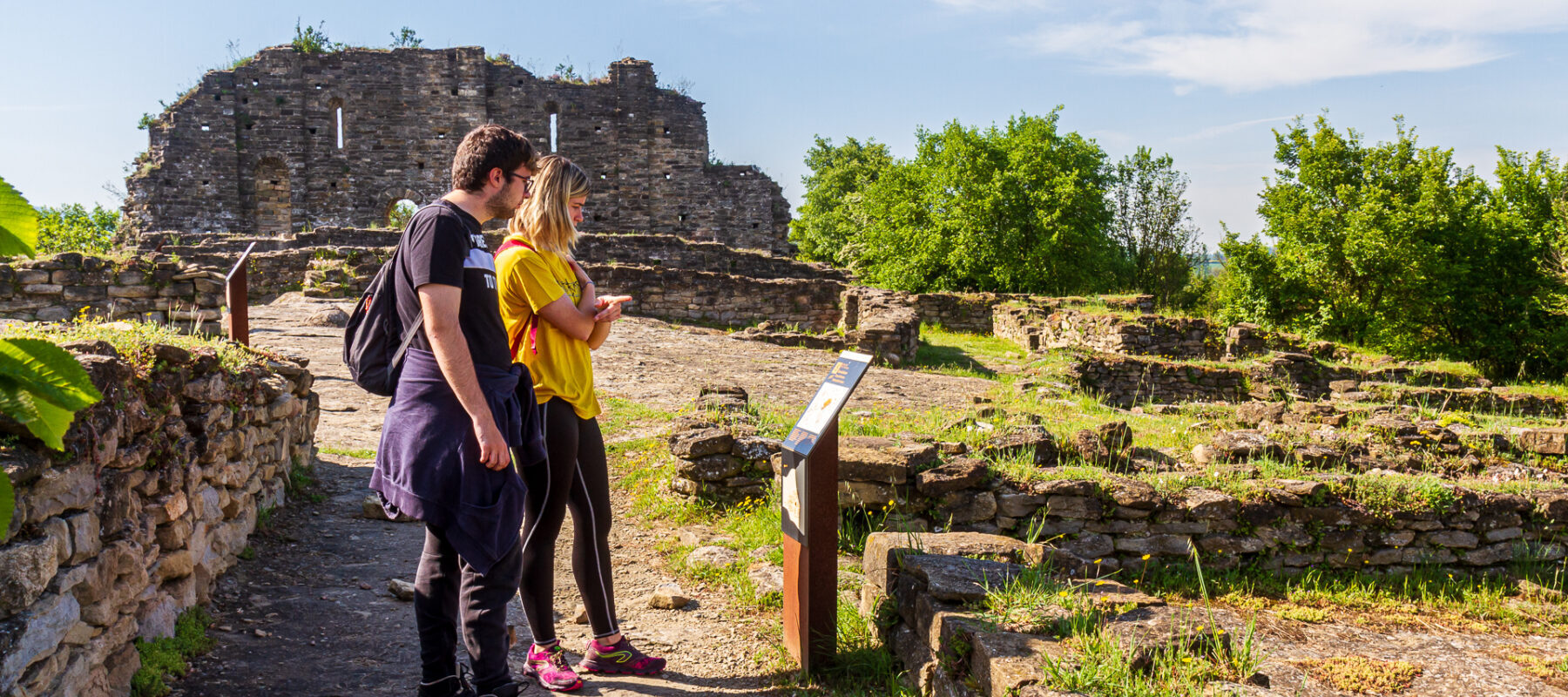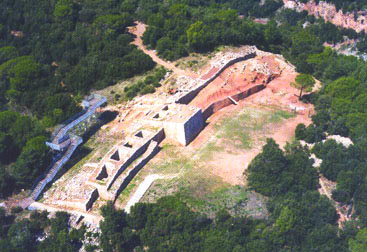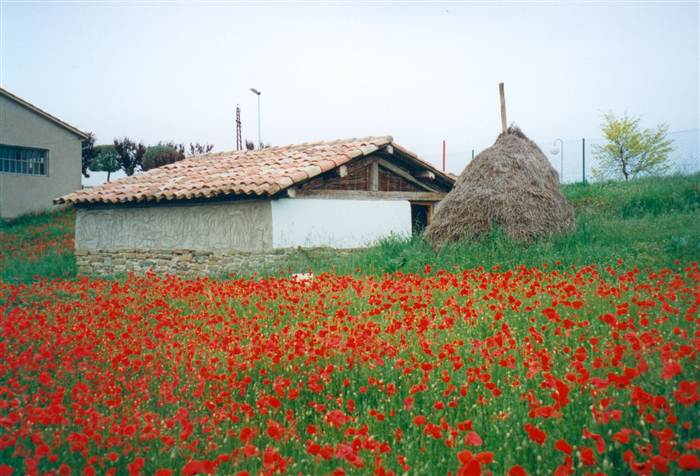Archaeology

A variety of archaeological sites can be visited.These archaelogical sites form part of the Route of the Iberians, which allows you to discover the remains of one of the most important cultures of the peninsula. The Iberian territory was occupied by various tribes between the 6th and 1st centuries BC. The Ausetan Iberians inhabited Osona and are recognised for the fortified villages located at strategic control points of the territory.
A clear example of an archaeological site located at a strategic point is l’Esquerda (Les Masies de Roda), located at 462 m above sea level, which made use of the cliffs of a meander of the River Ter to gain a strategic view to overlook and control the Plain.It was a strategic enclave during prehistoric times, through the Iberian period and until the Middle Ages. Today, we can view the remains that testify to the past, as we enjoy the wonderful views of the surrounding countryside.
L’Esquerda has been the favorite monument of Catalans 2019, for more information:
https://www.sapiens.cat/monumentfavorit/
More information: L’Esquerda Archaeological Museum,C/ Pere Baurier, s/n,08510 Roda de Ter– Tel. 93 854 02 71 – m.a.esquerda@rodadeter.cat –www.lesquerda.cat
Guided visit through the Iberian and Medieval site of l’Esquerda:
– Lenght: 2,5h
– Recommended period: All year, highly recommended in spring and autumn.
– Max/min. number per group: Maximum from 20 to 30 people. Minimum on request
– Languages: Catalan, Spanishm, French, Italian, English
– Approximate price: 3,5 € per person.
Guided visit: Botanical tour in l’Esquerda:
The tour offers the visitor a chance to learn about the natural vegatation from the region and its evolution from ancient times to now. You’ll be able to see plants, grown in experimental fields, and reproduced from sements archaelogical documented in the site.
– Lenght: 1,5 h
– Recommended period: All year specially in spring.
– Minimum age: 7 years
– Languages: Catalan, Spanish
– Approximate price: 3,5 € per person.
Camp de les Lloses, situated in Tona town centre, is a site from the Ibero-Roman period, which was from between the 2nd and 1st centuries B.C. It was formed by rectangular structures with interior portions. The amazing thing is the strength of the walls, as well as the information provided by the various elements exhibited in the museum-interpretation centre. Also, at the site are displays of objects and tools that were found, as well as explanations of how these objects and tools were once used by the inhabitants.
More information: Interpretation Center Camp de les Lloses – C/Pau Casals, 2 – Tona – Tel. 938 887 305 – campdeleslloses@e-tona.net – www.campdeleslloses.cat
Guided visit “The water tour in Tona: from Romans to the spas from the last century”.
– Lenght: 2h visit and workshop, and the water tour is between 2 and 3 hours.
– Accessible activity: The visit in the museum is adapted to those with physical disabilities.
– Recommended period: Spring and autumn
-Max/min. number per group:: 30 / 10 people
– Minimum age: 3 years
– Languages: Catalan, Spanish. French and English on request
– Approximate prices: Between 2 and 3 euros par person depending on the activity

The Montgrós Iberian Fortification is located in the municipality of El Brull, within the Montseny Natural Park. This fortified settlement comprises a five-metre-thick wall, stretching 150 metres, standing behind a pit and strengthened by peripheral defensive structures.
More information: El Brull Information Centre – Plaça de l’ajuntament, s/n – El Brull – Tel. 938 840 692 –p.montseny.brull@diba.cat – www.elbrull.cat
Guided routes:
The tour of the Montgrós walls departs from the El Brull Information Centre, housed in the old rectory. Accompanied by an archaeologist, you drive (in your own car) to the settlement, located 4.5 km from the town, where there is a large car park. The tour begins with an introduction to the world of the Iberians. As you explore the traces left by the Iberians, you’ll discover the hidden secrets of the impressive wall.
– Duration: 1 hour 45 minutes (you need to be at the Information Centre 10 minutes before the start of the tour)
– Recommended time of year: all year round.
– Min./max. no. people per group: 1-8 people (group visits must be pre-booked).
– Opening hours: visits on Saturday, Sunday and public holidays: January and February at 12:00; from March to June from 11:00 to 13:00; from July to September at 11:00, at 13:00 and at 16:00; from October to December at 11:00 and at 13:00.
Approximate prices:
standard admission €3 (adults); reduced admission €2 (pensioners and children under 16 years old); free admission for children under 6 years old.
Visit the archaelogical excavations in one of the first Catalan castles. (Property of Ermessenda of Carcassone, Countess of Barcelona, who was the leading role in one chapter from the soap opera called “Sota Terra” broadcoasted on channel TV3.) Circular tour on foot is about 3 km in duration.
More information: Grup Sotacingles – C/ Santa Maria, 5 – 08519 Vilanova de Sau – Tel. 93 884 71 04 –info@sotacingles.com

Puig Ciutat is a settlement which in its final phase of occupancy, during the period of the late Roman Republic, is likely to have housed a garrison, functioning as the praesidia (Roman fort) of the area at a time of great instability when the Great Roman Civil War took place between Julius Caesar and the Optimates (the faction of the Roman Senate supported by Pompey (mid-1st century BC). The history of the settlement also comprises two previous periods of occupancy: an Iberian phase (4th – 2nd century BC, approximately), the traces of which have been largely erased by the subsequent Roman occupancy, and an earlier Late Bronze – Early Iron phase (9th – 7th century BC, approximately), about which little is known.
The Puig Ciutat project was launched in 2010. From the start, it has involved the planning of archaeological tasks through the exploration of the site and the surrounding area using geophysical methods. Various tools have gradually been incorporated in order to create digital records of the results of excavation works.
Puig Ciutat is a multidisciplinary project whose main goal is to serve as a test site for the application of new archaeological methods and for the interactive and community-focused dissemination of information.
The project is based on the combination of different geophysical prospecting methods and the horizontal excavation of several rooms detected by means of this system. Various tools have gradually been incorporated to create digital records of the results of the excavation works (photogrammetry, geographical information systems, etc.), thus optimising time and resources while facilitating the dissemination of the results obtained.
More information: www.puigciutat.com
tornar enrere








